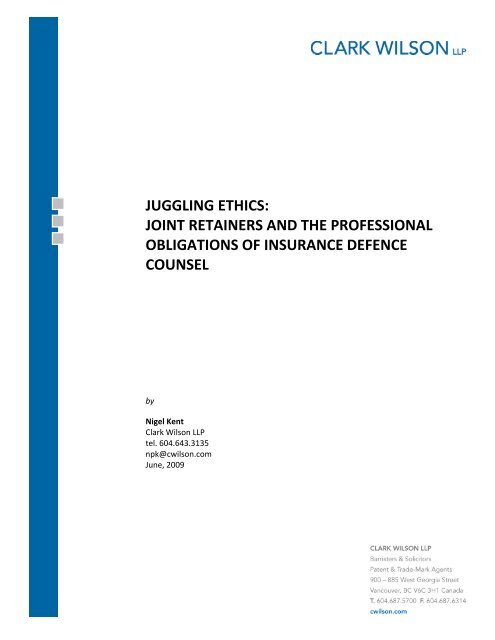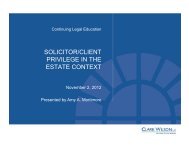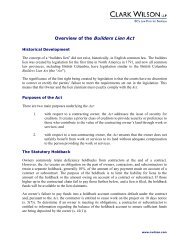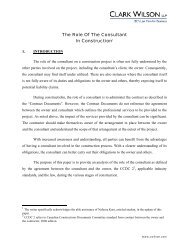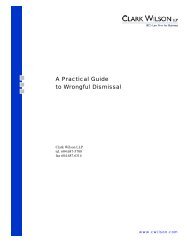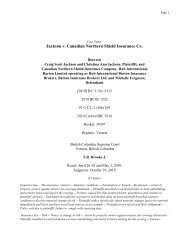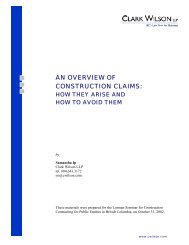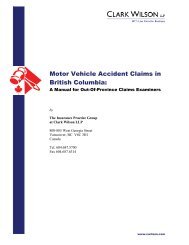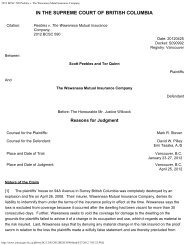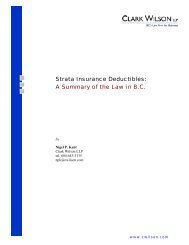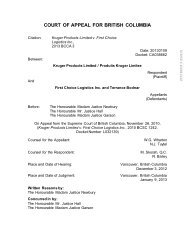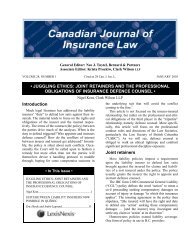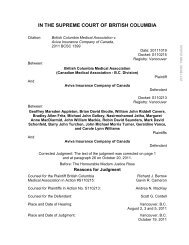juggling ethics: joint retainers and the ... - Clark Wilson LLP
juggling ethics: joint retainers and the ... - Clark Wilson LLP
juggling ethics: joint retainers and the ... - Clark Wilson LLP
You also want an ePaper? Increase the reach of your titles
YUMPU automatically turns print PDFs into web optimized ePapers that Google loves.
JUGGLING ETHICS:<br />
JOINT RETAINERS AND THE PROFESSIONAL<br />
OBLIGATIONS OF INSURANCE DEFENCE<br />
COUNSEL<br />
by<br />
Nigel Kent<br />
<strong>Clark</strong> <strong>Wilson</strong> <strong>LLP</strong><br />
tel. 604.643.3135<br />
npk@cwilson.com<br />
June, 2009
TABLE OF CONTENTS<br />
INTRODUCTION ................................................................................................................................... 1<br />
JOINT RETAINERS ................................................................................................................................. 1<br />
POTENTIAL CONFLICTS OF INTEREST BETWEEN INSURER AND INSURED ............................................... 4<br />
LAW SOCIETY RULES AND MANDATES .................................................................................................. 5<br />
MARA V. BLAKE: DOES CONTRACT TRUMP PROFESSIONAL CONDUCT CODES? ................................... 10<br />
THE REAL WORLD: PRACTICAL SOLUTIONS OR ETHICAL COMPROMISE? ............................................. 12<br />
APPENDICES:<br />
Appendix 1 ‐ 1999 LSBC Ethics Committee opinion respecting insurer litigation h<strong>and</strong>ling <strong>and</strong> billing<br />
guidelines;<br />
Appendix 2 ‐ October 2003 LSBC “Alert!” publication re “Avoiding Allegations of Bad Faith <strong>and</strong><br />
Professional Negligence in Defending Third‐Party Liability Claims”;<br />
Appendix 3 ‐ July/August 2006 LSBC Ethics Committee opinion re: “Lawyers Obligations Under ICBC<br />
Defence Retainers”;<br />
Appendix 4 ‐ July/August 2006 LSBC Bencher’s Bulletin re: Draft Policy for Discussion “Joint Retainers in<br />
<strong>the</strong> Defence of Third‐Party Liability Claims‐What should be a Lawyers Obligations”;<br />
Appendix 5 ‐ October 2008 LSBC Bencher’s Bulletin “Third‐Party Liability Claims”.<br />
© 2009 <strong>Clark</strong> <strong>Wilson</strong> <strong>LLP</strong> cwilson.com<br />
Nigel P. Kent, T. 604.643‐3135
JUGGLING ETHICS: JOINT RETAINERS<br />
AND THE PROFESSIONAL OBLIGATIONS<br />
OF INSURANCE DEFENCE COUNSEL<br />
“It seems likely that not all lawyers who practice in this area [Insurance Defence] are complying<br />
with <strong>the</strong>ir [PCH] obligations”. LSBC, 2006<br />
“The Rules of Professional Conduct, not <strong>the</strong> insurance contract, govern <strong>the</strong> [Defence] lawyers’<br />
obligations to <strong>the</strong> insured”. LSBC – 2008<br />
INTRODUCTION<br />
Much legal literature has addressed <strong>the</strong> liability insurer’s “duty” to defend law suits against <strong>the</strong>ir<br />
insureds. The material tends to focus on <strong>the</strong> rights <strong>and</strong> obligations of <strong>the</strong> insurer <strong>and</strong> <strong>the</strong> insured<br />
respectively. The terms of <strong>the</strong> contract (<strong>the</strong> policy) between <strong>the</strong> parties drive much of <strong>the</strong> analyses.<br />
When is <strong>the</strong> duty to defend triggered? Who appoints <strong>and</strong> instructs defence counsel? How do <strong>the</strong><br />
conflicts of interest between insurer <strong>and</strong> insured get addressed? Invariably, <strong>the</strong> policy is silent about<br />
such conflicts. Occasionally <strong>the</strong> Court will be called upon to fashion a remedy but more often than not<br />
<strong>the</strong> parties will <strong>the</strong>mselves devise a h<strong>and</strong>ling protocol to muddle through, hoping for some compromise<br />
outcome in <strong>the</strong> underlying suit that will avoid <strong>the</strong> conflict coming to <strong>the</strong> fore. 1<br />
This paper is not focused on <strong>the</strong> insurer–insured relationship, but ra<strong>the</strong>r on <strong>the</strong> professional <strong>and</strong> ethical<br />
obligations of <strong>the</strong> third player in <strong>the</strong> “tripartite” relationship, namely, defence counsel. More<br />
specifically, this paper will focus on <strong>the</strong> professional conduct rules <strong>and</strong> directions of <strong>the</strong> Law Societies,<br />
particularly <strong>the</strong> Law Society of British Columbia (“:LSBC”). As we will see, defence counsel is obliged to<br />
walk an ethical tightrope <strong>and</strong> confront significant professional discipline exposure.<br />
JOINT RETAINERS<br />
Most liability policies impose a requirement upon <strong>the</strong> liability insurer to defend law suits brought against<br />
<strong>the</strong> insured for claims <strong>and</strong> liabilities of a sort insured under <strong>the</strong> policy. The policy usually grants <strong>the</strong><br />
insurer <strong>the</strong> right to appoint <strong>and</strong> instruct defence counsel.<br />
The IBC form 2100 Commercial General Liability (CGL) policy defines <strong>the</strong> word “action” to mean a civil<br />
proceeding seeking compensatory damages on account of injury or damage “to which this insurance<br />
applies”. The insuring agreement in <strong>the</strong> policy <strong>the</strong>n stipulates, “[<strong>the</strong> insurer] will have <strong>the</strong> right <strong>and</strong> duty<br />
1 The most common mechanism for muddling through is <strong>the</strong> use of a non‐waiver agreement or a reservation of<br />
rights letter which will allow <strong>the</strong> underlying liability claim to be defended <strong>and</strong> conflict issues to be determined<br />
later: see N.P. Kent “Preventative Paper Work: Non‐Waiver Agreements, Reservation–of Rights Letters <strong>and</strong> <strong>the</strong><br />
Defence of Claims in Questionable Coverage Situations” (1995) 17 Adv. Q. 399.<br />
© 2009 <strong>Clark</strong> <strong>Wilson</strong> <strong>LLP</strong> cwilson.com<br />
Nigel P. Kent, T. 604.643‐3135.
p. 2<br />
to defend any “action” seeking those compensatory damages … [<strong>and</strong> <strong>the</strong> insurer] may investigate <strong>and</strong><br />
settle any claim or “action” at its discretion”.<br />
Homeowners policies extend liability coverage. One form of policy in use in B.C. provides:<br />
“Defence of lawsuits: [<strong>the</strong> insurer] will defend any action against [<strong>the</strong> insured] claiming<br />
compensatory damages on account of legal liability insured by this policy. [The insurer] will<br />
defend any such action even if it is completely groundless. [The insurer] reserves <strong>the</strong> exclusive<br />
right to appoint <strong>and</strong> instruct legal counsel in <strong>the</strong> defence <strong>and</strong> settlement of any such action as<br />
[<strong>the</strong> insurer] in [its] absolute discretion considers appropriate”.<br />
In British Columbia, that Province’s plan of universal compulsory vehicle insurance is operated by ICBC<br />
pursuant to <strong>the</strong> Insurance (Vehicle) Act, R.S.B.C. 1996, c. 231 as amended <strong>and</strong> <strong>the</strong> Insurance (Vehicle)<br />
Regulation, B.C. Reg. 447/83. Sections 74 <strong>and</strong> 74.1 of <strong>the</strong> Regulation address <strong>the</strong> defence of claims<br />
arising out of motor vehicle accidents:<br />
“74. … <strong>the</strong> Corporation, at its expense, shall<br />
(a)<br />
assist <strong>the</strong> insured by investigating <strong>and</strong> negotiating a settlement where, in <strong>the</strong><br />
Corporation’s opinion its assistance is necessary, <strong>and</strong><br />
(b) … defend in <strong>the</strong> name of <strong>the</strong> insured any action for damages brought against <strong>the</strong><br />
insured<br />
74.1 … on assuming <strong>the</strong> defence of an action for damages brought against an insured, <strong>the</strong><br />
Corporation shall have exclusive conduct <strong>and</strong> control of <strong>the</strong> defence of <strong>the</strong> action <strong>and</strong>, without<br />
limiting <strong>the</strong> generality of <strong>the</strong> foregoing, <strong>the</strong> Corporation shall be entitled<br />
(a)<br />
(b)<br />
(c)<br />
appoint <strong>and</strong> instruct counsel to defend <strong>the</strong> action,<br />
admit liability, in whole or in part, on behalf of <strong>the</strong> insured …<br />
compromise or settle <strong>the</strong> action.”<br />
These insurance policy provisions contemplate that <strong>the</strong> insurer will appoint a lawyer to defend <strong>the</strong><br />
insured <strong>and</strong> also, to varying degrees, purport to vest <strong>the</strong> insurer with <strong>the</strong> authority to instruct that<br />
lawyer to h<strong>and</strong>le <strong>the</strong> claim as <strong>the</strong> insurer wishes. So clearly, <strong>the</strong> insured, <strong>the</strong> very person whom <strong>the</strong><br />
lawyer is representing in <strong>the</strong> law suit, becomes a client of that lawyer. Is <strong>the</strong> insurance company, <strong>the</strong><br />
one that appoints, pays <strong>and</strong> instructs <strong>the</strong> lawyer, also a client?<br />
There is one Canadian case, widely considered by <strong>the</strong> insurance bar to be wrongly decided on this point,<br />
which has held that insurer–appointed defence counsel has only one client, namely, <strong>the</strong> insured. In<br />
Hopkins v. Wellington, [1999] BCJ No. 1164 (SC), <strong>the</strong> Court declared “<strong>the</strong> only client is <strong>the</strong> insured even<br />
though <strong>the</strong> insured has, by virtue of <strong>the</strong> contract of insurance, delegated <strong>the</strong> choice of his or her counsel<br />
to <strong>the</strong> insurer”. 2 The Court expressed disapproval of <strong>the</strong> notion that “defence counsel is also acting on<br />
behalf of <strong>the</strong> insurer <strong>and</strong> has a duty to protect <strong>the</strong> insurer’s interests” <strong>and</strong> went on, to observe:<br />
2 para. 9<br />
© 2009 <strong>Clark</strong> <strong>Wilson</strong> <strong>LLP</strong> cwilson.com<br />
Nigel P. Kent, T. 604.643‐3135.
p. 3<br />
<br />
<br />
<br />
<br />
<br />
ordinarily information in <strong>the</strong> possession of defence counsel would have to be shared with <strong>the</strong><br />
client (<strong>the</strong> insured);<br />
this would include any opinion which those lawyers may have issued to <strong>the</strong> insurers regarding<br />
coverage;<br />
any such coverage analysis “should not have been undertaken” by defence counsel, but ra<strong>the</strong>r<br />
“<strong>the</strong> insurers should have obtained separate counsel for that purpose”;<br />
if defence counsel did provide coverage information/analyses to <strong>the</strong> insurer “as a result of a<br />
separate retainer”, <strong>the</strong>n “<strong>the</strong> [lawyer’s] obligation of confidentiality owed to <strong>the</strong>ir clients, <strong>the</strong><br />
insurers, comes in conflict with <strong>the</strong> obligations <strong>the</strong>y owe to <strong>the</strong>ir clients, <strong>the</strong> defendant‐insured<br />
… <strong>and</strong> in those circumstances <strong>the</strong> lawyers must withdraw from fur<strong>the</strong>r acting for <strong>the</strong><br />
defendants‐insured”;<br />
however, if <strong>the</strong>y can continue to act, defence counsel “are not in a position to pass to <strong>the</strong><br />
insurers any confidential communications received from <strong>the</strong> defendant‐insured or confidential<br />
information while acting for <strong>the</strong> defendant‐insured if that information would or might prejudice<br />
coverage or if that information is o<strong>the</strong>rwise protected by solicitor‐client privilege”.<br />
However, it is <strong>the</strong> almost universal view of <strong>the</strong> insurance bar that <strong>the</strong> appointment by a liability insurer<br />
of defence counsel to defend a lawsuit against an insured is in fact a “<strong>joint</strong> retainer” <strong>and</strong> that defence<br />
counsel has two clients, namely, insurer <strong>and</strong> insured:<br />
“It is well established that <strong>the</strong> relationship between defence counsel, <strong>the</strong> insurer <strong>and</strong> <strong>the</strong><br />
insured constitutes a <strong>joint</strong> retainer (Groom v. Crocker, [1938] 2 All ER 394; Chersinoff v. All State<br />
(1968) 69 DLR (2d) 653 (BCSC), appeal allowed in part (1969), 3 DLR (3d) 560 (BCCA)). Defence<br />
counsel st<strong>and</strong>s in a solicitor‐client relationship with both <strong>the</strong> insurer <strong>and</strong> <strong>the</strong> insured, <strong>and</strong> owes<br />
professional duties to each.” 3 .<br />
In <strong>the</strong> Chersinoff case <strong>the</strong> Court commented on <strong>the</strong> appointment of defence counsel in a fatal accident<br />
law suit:<br />
“The starting point must be that <strong>the</strong> solicitors were acting as solicitors for both insurer <strong>and</strong><br />
insured in respect to <strong>the</strong> claims for damages brought against <strong>the</strong> latter. Although <strong>the</strong> insured<br />
did not select <strong>the</strong> solicitors himself but was represented by <strong>the</strong>m <strong>and</strong> became <strong>the</strong>ir client<br />
because of <strong>the</strong> contractual right of <strong>the</strong> insurer to conduct <strong>the</strong> defence <strong>and</strong> select <strong>the</strong> solicitors,<br />
<strong>the</strong> insured agreed as a condition of being indemnified that <strong>the</strong> insurer should have <strong>the</strong> right to<br />
select solicitors, so I think <strong>the</strong> insured may properly be taken to be a party of <strong>the</strong> employment of<br />
<strong>the</strong> solicitors selected. While <strong>the</strong> employment of <strong>the</strong> same solicitors for both parties came<br />
about because of <strong>the</strong> condition, <strong>the</strong> position of <strong>the</strong> solicitors in my view is that <strong>the</strong>y must be<br />
regarded as having been <strong>joint</strong>ly retained to represent both parties on <strong>the</strong> issues of whe<strong>the</strong>r or<br />
3 J. S. Olsen, “The Tripartite Relationship”, a paper prepared for <strong>the</strong> Continuing Legal Education Society of British<br />
Columbia, Insurance Law Conference, 2002. Mr. Olsen is in‐house counsel with <strong>the</strong> Law Society of B.C. <strong>and</strong> advises<br />
on professional <strong>ethics</strong>.<br />
© 2009 <strong>Clark</strong> <strong>Wilson</strong> <strong>LLP</strong> cwilson.com<br />
Nigel P. Kent, T. 604.643‐3135.
p. 4<br />
not <strong>the</strong> insured was liable to pay damages in respect to <strong>the</strong> motor accident <strong>and</strong> <strong>the</strong> amount of<br />
<strong>the</strong> damages”. 4<br />
While it is possible some debate may remain in <strong>the</strong> case law, <strong>the</strong>re is no question that <strong>the</strong> Law Society of<br />
B. C. considers <strong>the</strong> appointment by a liability insurer of defence counsel to represent an insured to be a<br />
situation of <strong>joint</strong> retainer. All <strong>the</strong> Law Societies along with <strong>the</strong> Canadian Bar Association, have<br />
promulgated codes of professional conduct which include rules addressing conflicts of interest between<br />
clients. These rules, which are referred to in greater detail below, are drawn in general terms <strong>and</strong> are<br />
not specifically directed to <strong>the</strong> retainer by a liability insurer of defence counsel for an insured.<br />
However, <strong>the</strong> Law Society of British Columbia, more so than any o<strong>the</strong>r Law Society in Canada, has<br />
chosen to specifically address <strong>the</strong> implications of <strong>the</strong> tripartite relationship in <strong>the</strong> context of liability<br />
insurance on several different occasions over <strong>the</strong> years, including insurer‐imposed litigation <strong>and</strong> billing<br />
guidelines (1999), professional negligence in defending third party liability claims (2003), <strong>the</strong> ICBC<br />
“Strategic Alliance Agreement” with its defence law firms (2006) <strong>and</strong> “Third Party Liability Claims” (2008)<br />
5 . From <strong>the</strong> outset <strong>the</strong> LSBC has very clearly stated that “Lawyers defending a claim for damages<br />
pursuant to a policy of insurance … act for both <strong>the</strong> insured <strong>and</strong> <strong>the</strong> insurer”. 6 In its October 2003<br />
bulletin to <strong>the</strong> profession respecting professional negligence in defending third‐party liability claims, <strong>the</strong><br />
LSBC,<br />
“A lawyer appointed by an insurer to defend a third‐party liability claim has two clients: <strong>the</strong><br />
insurer <strong>and</strong> <strong>the</strong> insured. The lawyer owes obligations to both clients … care must be taken by<br />
<strong>the</strong> lawyer to identify <strong>and</strong> avoid conflicts of interest between <strong>the</strong> two clients <strong>and</strong> to ensure that<br />
<strong>the</strong>y are both fully protected”.<br />
The LSBC also issued a bulletin to <strong>the</strong> profession in August 2006 circulating a “draft policy for<br />
discussion”. It was entitled “Joint Retainers in <strong>the</strong> Defence of Third‐Party Liability Claims” <strong>and</strong> it went on<br />
to observe “it seems likely that not all lawyers who practice in this area are complying with <strong>the</strong>ir<br />
obligations [set out in] <strong>the</strong> Professional Conduct H<strong>and</strong>book”. 7 These statements, combined with a<br />
subsequent bulletin issued October 2008 entitled “Third‐Party Liability Claims”, make it very clear that in<br />
so far as <strong>the</strong> LSBC is concerned, <strong>the</strong> appointment by a liability insurer of defence counsel to represent an<br />
insured is indeed a “<strong>joint</strong> retainer” <strong>and</strong> carries with it certain professional <strong>and</strong> ethical obligations <strong>the</strong><br />
breach of which will put <strong>the</strong> defence counsel at risk of disciplinary proceedings.<br />
POTENTIAL CONFLICTS OF INTEREST BETWEEN INSURER AND INSURED<br />
In Fredrikson v. ICBC, (1990) 44 BCLR (2d) 303 (SC), Esson CJSC observed <strong>the</strong> “element of conflict is a<br />
necessary incident of <strong>the</strong> contract [of insurance <strong>and</strong>] in <strong>the</strong> relationship between insurer <strong>and</strong> insured”.<br />
As one author has observed,<br />
4 (1968) 69 DLR (2d) 653 at 660‐61.<br />
5 See Appendices for <strong>the</strong>se notices/bulletins<br />
6 Law Society Ethics Committee Opinion re: Third Party Auditors, May 6, 1999<br />
7 In Olsen, supra. n.3, it was observed “It is not common practice for counsel representing insurer <strong>and</strong> insureds to<br />
advise <strong>the</strong>ir clients in <strong>the</strong> terms required by CH. 6 of <strong>the</strong> PCH”.<br />
© 2009 <strong>Clark</strong> <strong>Wilson</strong> <strong>LLP</strong> cwilson.com<br />
Nigel P. Kent, T. 604.643‐3135.
p. 5<br />
“It is commonplace for <strong>the</strong>re to be ‘conflicts’ or adverse interests between <strong>the</strong> insurer <strong>and</strong> <strong>the</strong><br />
insured in <strong>the</strong> course of defending a third party’s claim on such issues as tactics, whe<strong>the</strong>r or not<br />
to settle <strong>and</strong> for how much, <strong>and</strong> how much to spend on investigation <strong>and</strong> defence preparation.<br />
These are not unacceptable conflicts; as stated in Fredrikson, <strong>the</strong>y are inherent in <strong>the</strong><br />
relationship”. 8<br />
It is not difficult to imagine numerous liability defence scenarios where <strong>the</strong> interest of insurer <strong>and</strong><br />
insured may differ <strong>and</strong> ultimately conflict. A partial list might include <strong>the</strong> following:<br />
<br />
<br />
<br />
<br />
<br />
disagreement as to <strong>the</strong> selection <strong>and</strong> appointment of defence counsel;<br />
allegations of multiple or alternative claims (damages or causes of loss) some of which are<br />
covered by <strong>the</strong> policy <strong>and</strong> some of which are not;<br />
reservation of rights by <strong>the</strong> insurer to later deny coverage in <strong>the</strong> event that a policy breach or a<br />
mis‐representation voiding coverage can later be substantiated;<br />
claims for damages which exceed <strong>the</strong> available policy limits <strong>and</strong> which, if not settled, may<br />
expose <strong>the</strong> insured for personal liability that is not covered by <strong>the</strong> policy;<br />
disagreement whe<strong>the</strong>r or not to settle <strong>the</strong> case.<br />
When <strong>the</strong>se conflicts arise, it is not uncommon for <strong>the</strong> insured to attempt to seize control of <strong>the</strong><br />
defence of <strong>the</strong> claim, albeit at <strong>the</strong> expense of <strong>the</strong> insurer. Depending on <strong>the</strong> nature of <strong>the</strong> conflict, in<br />
various cases <strong>the</strong> Courts have been prepared to make orders granting <strong>the</strong> insured <strong>the</strong> right to appoint<br />
<strong>and</strong> instruct defence counsel, restricting <strong>the</strong> nature <strong>and</strong> extent of reporting by defence counsel to <strong>the</strong><br />
insurer, <strong>and</strong> so on. 9<br />
Caught in <strong>the</strong> middle of this coverage tug of war is <strong>the</strong> defence counsel who has professional duties of<br />
loyalty <strong>and</strong> confidentiality to both <strong>the</strong> insurer <strong>and</strong> <strong>the</strong> insured. What guidance can that hapless lawyer<br />
draw from <strong>the</strong> Rules of Professional Conduct promulgated by Law Societies or Bar Associations? That<br />
lawyer, who after all will usually have a special relationship with <strong>the</strong> insurer developed over many years<br />
of <strong>retainers</strong>, must tread very carefully indeed.<br />
LAW SOCIETY RULES AND MANDATES<br />
Most Law Societies have issued a professional conduct rule respecting impartiality <strong>and</strong> conflict of<br />
interest between clients similar to Chapter V of <strong>the</strong> CBA Code of Professional Conduct. That Rule is<br />
stated to be:<br />
8 D. S. Ferguson, “Conflict Between Insured <strong>and</strong> Insurer: An Analysis of Recent Canadian Cases”, (1990) 12 ADV. Q.<br />
129. There are many o<strong>the</strong>r articles which have addressed this issue as <strong>the</strong> case law has developed including for<br />
example B. Billingsley, “Caught in <strong>the</strong> Middle: When Liability Insurance Defence Counsel Encounter Coverage<br />
Problems” (2000) 79 CBR 221, L. Anderson & P. Walker “The Duty to Defend Partially Covered Claims: Legal &<br />
Ethical Considerations” (2008) PBLI Insurance Coverage Symposium.<br />
9 See <strong>the</strong> seminal Canadian case of Laurencine v. Jardine (1988) 30 CCLI 187 (Ont. HCJ) <strong>and</strong> <strong>the</strong> extensive judicial<br />
consideration in numerous subsequent cases as discussed in <strong>the</strong> articles referred to in footnote 7 above.<br />
© 2009 <strong>Clark</strong> <strong>Wilson</strong> <strong>LLP</strong> cwilson.com<br />
Nigel P. Kent, T. 604.643‐3135.
p. 6<br />
“The lawyer shall not advise or represent both sides of a dispute <strong>and</strong>, except after adequate<br />
disclosure to <strong>and</strong> with <strong>the</strong> consent of <strong>the</strong> clients or prospective clients concerned, shall not act<br />
or continue to act in a matter when <strong>the</strong>re is or is likely to be a conflicting interest.”<br />
The related “guiding principle” set out in <strong>the</strong> Code commentary continues:<br />
“Before <strong>the</strong> lawyer accepts employment from more than one client in <strong>the</strong> same matter, <strong>the</strong><br />
lawyer must advise <strong>the</strong> clients that <strong>the</strong> lawyer has been asked to act for both or all of <strong>the</strong>m, that<br />
no information received in connection with <strong>the</strong> matter from one can be treated as confidential<br />
so far as any of <strong>the</strong> o<strong>the</strong>rs is concerned <strong>and</strong> that, if a dispute develops that cannot be resolved,<br />
<strong>the</strong> lawyer cannot continue to act for both or all of <strong>the</strong>m with respect to <strong>the</strong> matter <strong>and</strong> may<br />
have to withdraw completely. Where a lawyer has a continuing relationship with a client for<br />
whom <strong>the</strong> lawyer acts regularly, before <strong>the</strong> lawyer accepts <strong>joint</strong> employment for that client <strong>and</strong><br />
ano<strong>the</strong>r client in a matter or transaction, <strong>the</strong> lawyer must advise <strong>the</strong> o<strong>the</strong>r client of <strong>the</strong><br />
continuing relationship <strong>and</strong> recommend that <strong>the</strong> o<strong>the</strong>r client obtain independent legal advice<br />
about <strong>the</strong> <strong>joint</strong> retainer. If, following such disclosure, all parties are content that <strong>the</strong> lawyer act<br />
for <strong>the</strong>m, <strong>the</strong> lawyer should obtain <strong>the</strong>ir consent, preferably in writing, or record <strong>the</strong>ir consent<br />
in a separate letter to each. The lawyer should, however guard against acting for more than one<br />
client where, despite <strong>the</strong> fact that all parties concerned consent, it is reasonably obvious that a<br />
contentious issue may arise between <strong>the</strong>m or that <strong>the</strong>ir interests, rights or obligations will<br />
diverge as <strong>the</strong> matter progresses. … If a contentious issue arises between clients on a <strong>joint</strong><br />
retainer, <strong>the</strong> lawyer, although not necessarily precluded from advising <strong>the</strong>m on o<strong>the</strong>r noncontentious<br />
matters, would be in breach of <strong>the</strong> Rule if <strong>the</strong> lawyer attempted to advise <strong>the</strong>m on<br />
<strong>the</strong> contentious issue. In such circumstances <strong>the</strong> lawyer should ordinarily refer <strong>the</strong> clients to<br />
o<strong>the</strong>r lawyers.”<br />
Based on <strong>the</strong> above rule/principle, it would appear that in <strong>joint</strong> retainer situations, such as <strong>the</strong> insurer’s<br />
appointment of defence counsel to represent an insured,<br />
<br />
<br />
<br />
<br />
so long as <strong>the</strong>re is “adequate disclosure” <strong>and</strong> both insurer/insured consent, <strong>the</strong> defence lawyer<br />
is free to act even though <strong>the</strong>re “is or is likely to be” a conflict of interest between <strong>the</strong> two<br />
clients;<br />
<strong>the</strong> lawyer must advise both clients that <strong>the</strong>re is no confidentiality attached to any information<br />
received <strong>and</strong> that all such information can (<strong>and</strong> will) be released to both clients;<br />
<strong>the</strong> lawyer who has a long st<strong>and</strong>ing relationship with <strong>the</strong> insurer, should advise <strong>the</strong> insured of<br />
that long st<strong>and</strong>ing relationship (presumably as part of <strong>the</strong> adequate disclosure‐consent<br />
“process” referred to above); <strong>and</strong><br />
<strong>the</strong> lawyer must tell both clients that if a dispute develops between <strong>the</strong>m which cannot be<br />
resolved, <strong>the</strong>n he is not allowed to advise <strong>the</strong>m on <strong>the</strong> dispute <strong>and</strong> may have to withdraw from<br />
<strong>the</strong> retainer.<br />
We have already seen how The Law Society of British Columbia has expressly declared that <strong>the</strong><br />
appointment of defence counsel by a liability insurer for <strong>the</strong> benefit of <strong>the</strong> insured is a <strong>joint</strong> retainer.<br />
© 2009 <strong>Clark</strong> <strong>Wilson</strong> <strong>LLP</strong> cwilson.com<br />
Nigel P. Kent, T. 604.643‐3135.
p. 7<br />
This triggers certain general principles <strong>and</strong> m<strong>and</strong>atory procedures set out in Chapter 6 of that Law<br />
Society’s Professional Conduct H<strong>and</strong>book which provides as follows:<br />
General Principles<br />
Chapter 6<br />
Conflicts of Interest Between Clients<br />
1. As a general principle, a lawyer has a duty to give undivided loyalty to every client …<br />
3. A lawyer may, with informed client consent, represent clients in circumstances that<br />
might, in <strong>the</strong> future, give rise to divided loyalties.<br />
Acting for two or more clients<br />
4. A lawyer may <strong>joint</strong>ly represent two or more clients, if, at <strong>the</strong> commencement of <strong>the</strong><br />
retainer, <strong>the</strong> lawyer:<br />
(a)<br />
explains to each client <strong>the</strong> principle of undivided loyalty,<br />
(b) advises each client that no information received from one of <strong>the</strong>m as part<br />
of <strong>the</strong> <strong>joint</strong> representation can be treated as confidential as between <strong>the</strong>m,<br />
(c) receives from all clients <strong>the</strong> fully informed consent to one of <strong>the</strong> following<br />
courses of action to be followed in <strong>the</strong> event <strong>the</strong> lawyer receives from one client, in <strong>the</strong><br />
lawyer’s separate representation of that client, information relevant to <strong>the</strong> <strong>joint</strong><br />
representation:<br />
<strong>and</strong><br />
(i) <strong>the</strong> information must not be disclosed to <strong>the</strong> o<strong>the</strong>r <strong>joint</strong>ly represented clients,<br />
<strong>the</strong> lawyer must withdraw form <strong>the</strong> <strong>joint</strong> representation;<br />
(ii) <strong>the</strong> information must be disclosed to all o<strong>the</strong>r <strong>joint</strong> represented clients, <strong>and</strong><br />
<strong>the</strong> lawyer may continue to act for <strong>the</strong> clients <strong>joint</strong>ly, <strong>and</strong><br />
(d) secures <strong>the</strong> informed consent of each client (with independent legal advice, if<br />
necessary) as to <strong>the</strong> course of action that will be followed if a conflict arises between<br />
<strong>the</strong>m.<br />
5. If a lawyer <strong>joint</strong>ly represents two or more clients, <strong>and</strong> a conflict arises between any of<br />
<strong>the</strong>m, <strong>the</strong> lawyer must cease representing all <strong>the</strong> clients, unless all <strong>the</strong> clients:<br />
(a) consented, under paragraph 4(d) to <strong>the</strong> lawyer continuing to represent one<br />
of <strong>the</strong>m or a group of clients that have an identity of interests, or<br />
(b)<br />
give informed consent to <strong>the</strong> lawyer assisting all of <strong>the</strong>m to resolve <strong>the</strong> conflict.<br />
What this means is that it is m<strong>and</strong>atory for all defence counsel, upon <strong>the</strong>ir appointment as such, to<br />
advise both insurer <strong>and</strong> insured at <strong>the</strong> outset,<br />
© 2009 <strong>Clark</strong> <strong>Wilson</strong> <strong>LLP</strong> cwilson.com<br />
Nigel P. Kent, T. 604.643‐3135.
p. 8<br />
an explanation of <strong>the</strong> concept of undivided loyalty <strong>and</strong> his duties to each client in that regard; 10<br />
<br />
<br />
advise (a warning?) that none of <strong>the</strong> information received by <strong>the</strong> lawyer will be confidential as<br />
between <strong>the</strong> two clients <strong>and</strong> will be made available to each of <strong>the</strong>m; <strong>and</strong><br />
that an agreement is required as to what is to happen should a conflict arise between insurer<br />
<strong>and</strong> insured (which agreement must amount to “informed consent”, which in certain<br />
circumstances may even require <strong>the</strong> obtaining of independent legal advice).<br />
In this writer’s experience, spanning almost 30 years, <strong>the</strong> above requirement (a “Chapter 6 letter”) has<br />
been almost universally ignored by <strong>the</strong> insurance bar in British Columbia. For sure, some of <strong>the</strong><br />
concepts may have been incorporated into a sophisticated “Non‐Waiver Agreement” which <strong>the</strong> insurer<br />
may have presented to <strong>the</strong> insured in certain situations 11 . However, such a Non‐Waiver Agreement<br />
does not meet all of <strong>the</strong> requirements of Chapter 6 including <strong>the</strong> most obvious requirement that <strong>the</strong><br />
statements/explanations in question must come from <strong>the</strong> defence lawyer not <strong>the</strong> insurer.<br />
In early 1999 <strong>the</strong> LSBC became aware that insurers were increasingly imposing upon <strong>the</strong>ir defence<br />
lawyers formal litigation h<strong>and</strong>ling <strong>and</strong> billing guidelines. Those guidelines, which are now quite common<br />
place in <strong>the</strong> insurance industry, required defence lawyers to obtain <strong>the</strong> permission of <strong>the</strong> insurer before<br />
carrying out certain tasks in <strong>the</strong> litigation or before incurring certain expenses. They imposed caps or<br />
restrictions on rates for certain tasks <strong>and</strong> refused payment for o<strong>the</strong>r tasks. In addition, some insurers<br />
required <strong>the</strong> defence lawyer’s fee accounts to be submitted to external auditors for review <strong>and</strong> approval<br />
prior to payment.<br />
The Law Society was very concerned that <strong>the</strong> guidelines had <strong>the</strong> potential to interfere with counsels’<br />
professional judgment in <strong>the</strong> conduct of litigation <strong>and</strong> that <strong>the</strong> submission of an account to a third party<br />
auditor might, in <strong>the</strong> absence of informed consent from <strong>the</strong> insured, breach solicitor‐client privilege <strong>and</strong><br />
contravene <strong>the</strong> lawyer’s duty of loyalty <strong>and</strong> confidentiality to <strong>the</strong> insured. Ultimately, <strong>the</strong> Law Society<br />
issued opinions condoning <strong>the</strong> practices in question but urging defence lawyers to exercise caution 12 .<br />
In October 2003 <strong>the</strong> Law Society again ventured into <strong>the</strong> field of <strong>the</strong> appointment by insurers of lawyers<br />
to defend third party liability claims. This time <strong>the</strong> Law Society’s concern related to <strong>the</strong> increasing<br />
frequency of “bad faith” claims against liability insurers for failing to settle claims within policy limits <strong>and</strong><br />
to <strong>the</strong> related potential exposure of defence lawyers to professional negligence claims. The resulting<br />
“Alert!” bulletin issued to <strong>the</strong> profession 13 included, among o<strong>the</strong>r things, <strong>the</strong> following suggestions:<br />
<br />
“Write to insured at <strong>the</strong> outset to advise of <strong>the</strong> [<strong>joint</strong>] retainer, its scope <strong>and</strong> its limitations. Be<br />
sure that <strong>the</strong> insurer is also aware of <strong>the</strong> scope <strong>and</strong> limitations of <strong>the</strong> retainer;<br />
10 The LSBC in its sample Chapter 6 letter suggests: “We owe each of you a duty of undivided loyalty. This means<br />
that we must act in your best interests at all times <strong>and</strong> must not favor <strong>the</strong> interests of one of you over <strong>the</strong> interests<br />
of ano<strong>the</strong>r, or allow anything to interfere with our loyalty to you or our judgment on your behalf. If we are unable<br />
to fulfill this duty of undivided loyalty, we will have to withdraw from this <strong>joint</strong> representation”.<br />
11 See <strong>the</strong> sample agreement attached to N.P. Kent “Preventative Paper Work: Non‐Waiver Agreements,<br />
Reservation‐of Rights Letters <strong>and</strong> <strong>the</strong> Defence of Claims in Questionable Coverage Situations” (1995) 17 Adv. Q.<br />
399<br />
12 See Appendix 1<br />
13 Appendix 2<br />
© 2009 <strong>Clark</strong> <strong>Wilson</strong> <strong>LLP</strong> cwilson.com<br />
Nigel P. Kent, T. 604.643‐3135.
p. 9<br />
<br />
<br />
Once appointed to defend, do not advise ei<strong>the</strong>r party on insurance coverage issues. Do not act<br />
on behalf of <strong>the</strong> insurer in any action relating to insurance coverage issues (including Part 7<br />
actions). Be aware of what <strong>the</strong> coverage issues are, so that you can identify conflicts <strong>and</strong> avoid<br />
<strong>the</strong>m.”;<br />
“Be alive to <strong>the</strong> possibility of conflicts at all times.”<br />
In 2006 <strong>the</strong> Law Society became concerned about <strong>the</strong> implications of <strong>the</strong> so called “Strategic Alliance<br />
Agreement” which ICBC required of <strong>the</strong> law firms that represented insureds in <strong>the</strong> defence of motor<br />
vehicle claims. While <strong>the</strong> resulting Benchers’ Bulletin 14 did not expressly address professional conduct<br />
implications of <strong>the</strong> <strong>joint</strong> retainer, it did declare that <strong>the</strong> existence of <strong>the</strong> agreement required <strong>the</strong> law<br />
firm to withdraw from cases in certain circumstances <strong>and</strong> also made it m<strong>and</strong>atory for <strong>the</strong> lawyer to<br />
“advise clients of <strong>the</strong> lawyer’s relationship with ICBC <strong>and</strong> <strong>the</strong> implications of <strong>the</strong> restrictions <strong>the</strong> lawyer<br />
is under”.<br />
Also in 2006, <strong>the</strong> Law Society decided to directly address “Joint Retainers in <strong>the</strong> Defence of Third‐Party<br />
Liability Claims” <strong>and</strong>, in particular, “What Should be a Lawyer’s Obligations?”. A Benchers’ Bulletin 15<br />
was issued to <strong>the</strong> profession setting out a draft policy for discussion purposes. It noted no clear<br />
agreement existed between insurance practitioners on “several key issues”, notably,<br />
<br />
<br />
<br />
what advice should a lawyer give clients about a <strong>joint</strong> retainer?<br />
what circumstances require a lawyer to withdraw from a <strong>joint</strong> retainer?<br />
what information can <strong>the</strong> lawyer give to <strong>the</strong> parties when <strong>the</strong> lawyer is required to withdraw?<br />
It is in this Benchers’ Bulletin respecting <strong>joint</strong> <strong>retainers</strong> that <strong>the</strong> Law Society made <strong>the</strong> potentially<br />
ominous statement “it seems likely that not all lawyers who practice in this area [insurance defence] are<br />
complying with <strong>the</strong>ir obligations in Chapter 6, Rules 4 <strong>and</strong> 5 of <strong>the</strong> Professional Conduct H<strong>and</strong>book”.<br />
It was not until October 2008 that <strong>the</strong> Ethics Committee of <strong>the</strong> Law Society finalised <strong>and</strong> issued to <strong>the</strong><br />
profession its formal opinion respecting a lawyer’s obligations in <strong>joint</strong> retainer situations. The opinion<br />
essentially mirrored <strong>the</strong> original draft except,<br />
<br />
<br />
it did not repeat <strong>the</strong> observation that insurance defence practitioners were breaching <strong>the</strong> PCH<br />
obligations, <strong>and</strong><br />
it deleted <strong>the</strong> evidently controversial suggestion that “if a lawyer for an insured knows that <strong>the</strong><br />
insured objects to a settlement, <strong>the</strong> lawyer may not settle <strong>the</strong> claim against <strong>the</strong> insured at <strong>the</strong><br />
direction of <strong>the</strong> insurer, without giving <strong>the</strong> insured an opportunity to reject <strong>the</strong> defence offered<br />
by <strong>the</strong> insurer <strong>and</strong> to assume responsibility for <strong>the</strong> defence at <strong>the</strong> insured’s own expense”.<br />
The October 2008 Bulletin 16 expressed <strong>the</strong> Ethics Committee’s opinion that among o<strong>the</strong>r things,<br />
14 Appendix 3<br />
15 Appendix 4<br />
16 Appendix 5<br />
© 2009 <strong>Clark</strong> <strong>Wilson</strong> <strong>LLP</strong> cwilson.com<br />
Nigel P. Kent, T. 604.643‐3135.
p. 10<br />
<br />
<br />
<br />
<br />
<br />
if <strong>the</strong> lawyer is not appointed to represent <strong>the</strong> insured alone (which is rarely <strong>the</strong> case in most<br />
situations), <strong>the</strong>n <strong>joint</strong> representation of both <strong>the</strong> insurer <strong>and</strong> insured is permissible “with<br />
appropriate disclosure in accordance with Chapter 6 of <strong>the</strong> Professional Conduct H<strong>and</strong>book”;<br />
in any such <strong>joint</strong> retainer, “<strong>the</strong> lawyer has duties to both <strong>the</strong> insured <strong>and</strong> <strong>the</strong> insurer”, <strong>and</strong> must<br />
take care to identify <strong>and</strong> avoid conflicts of interests between <strong>the</strong> two clients;<br />
“so long as <strong>the</strong> insured is a client, <strong>the</strong> Rules of professional conduct‐<strong>and</strong> not <strong>the</strong> insurance<br />
contract‐govern <strong>the</strong> lawyer’s obligations to <strong>the</strong> insured”;<br />
“if, after commencing to act on a <strong>joint</strong> retainer, <strong>the</strong> lawyer receives information that evidences a<br />
conflict between <strong>the</strong> insured <strong>and</strong> <strong>the</strong> insurer, <strong>the</strong> lawyer must withdraw from <strong>the</strong> <strong>joint</strong><br />
representation without disclosing <strong>the</strong> information giving rise to <strong>the</strong> conflict”; 17<br />
“where <strong>the</strong> policy of insurance authorises <strong>the</strong> insurer to control <strong>the</strong> defence <strong>and</strong> to settle within<br />
policy limits in its sole discretion, <strong>the</strong> lawyer must inform <strong>the</strong> clients of those limitations on <strong>the</strong><br />
representation”. After <strong>the</strong> lawyer has communicated <strong>the</strong> necessary information respecting<br />
<strong>the</strong>se limitation to <strong>the</strong> insured, “<strong>the</strong> lawyer may settle at <strong>the</strong> direction of <strong>the</strong> insurer”<br />
(presumably even though <strong>the</strong> insured may object).<br />
It will be noted that <strong>the</strong> October 2008 Bulletin did not address <strong>the</strong> situation where <strong>the</strong> liability insurer is<br />
defending, <strong>and</strong> <strong>the</strong> defence counsel is appointed, pursuant to a “reservation of rights” or non‐waiveragreement<br />
scenario (for example, where claims may or may not be covered depending on <strong>the</strong> outcome<br />
of <strong>the</strong> case). The staff <strong>ethics</strong> lawyer for <strong>the</strong> LSBC takes <strong>the</strong> view that “independent legal advice is<br />
necessary for <strong>the</strong> <strong>joint</strong> clients in <strong>the</strong>se situations”. If so, it is presumably incumbent upon <strong>the</strong> defence<br />
lawyer to ensure this issue is addressed when <strong>the</strong> “Chapter 6 letter” is issued to <strong>the</strong> insured at <strong>the</strong><br />
outset of <strong>the</strong> retainer.<br />
MARA V. BLAKE: DOES CONTRACT TRUMP PROFESSIONAL CONDUCT CODES?<br />
In Mara v. Blake (1996), 23 BCLR (3d) 225 (CA) <strong>the</strong> hapless plaintiffs were involved in four different<br />
motor vehicle accidents over a span of four years. They issued four separate lawsuits against <strong>the</strong><br />
various motor vehicle defendants, all of whom were insured by ICBC. The insurer appointed <strong>the</strong> same<br />
lawyer to act as defence counsel for <strong>the</strong> various owners/operators who had been named as defendants.<br />
Liability was admitted in three of <strong>the</strong> law suits, although contributory negligence was alleged. In one of<br />
<strong>the</strong> actions, liability was denied.<br />
All four actions were ordered to be tried toge<strong>the</strong>r but at <strong>the</strong> commencement of <strong>the</strong> trial, <strong>the</strong> Judge<br />
raised concern about defence counsel being in a position of conflict in acting for all four groups of<br />
defendants. The Judge felt it would be necessary for four different counsel to appear for each group of<br />
defendants unless <strong>the</strong> insurer, ICBC, was prepared to ab<strong>and</strong>on <strong>the</strong> contributory negligence allegations<br />
<strong>and</strong> appoint separate counsel in <strong>the</strong> one action where liability was denied. ICBC refused <strong>and</strong> <strong>the</strong> trial<br />
17 The most common example of this is where <strong>the</strong> insured discloses information to <strong>the</strong> lawyer which places or may<br />
place <strong>the</strong> insurance coverage in jeopardy (“I drank 8 beer before I got into <strong>the</strong> car to drive”, “it wasn’t an accident<br />
… I meant to hurt him”)<br />
© 2009 <strong>Clark</strong> <strong>Wilson</strong> <strong>LLP</strong> cwilson.com<br />
Nigel P. Kent, T. 604.643‐3135.
p. 11<br />
Judge ordered that <strong>the</strong> trials be adjourned because of <strong>the</strong> <strong>joint</strong> representation “by <strong>the</strong> same counsel<br />
despite having divergent interests”.<br />
ICBC appealed. Given <strong>the</strong> issues involved, <strong>the</strong> Court of Appeal invited The Law Society of British<br />
Columbia to make representations.<br />
The Court of Appeal acknowledged that <strong>the</strong>re may be numerous circumstances of conflict in insurance<br />
defence cases including,<br />
<br />
<br />
<br />
<br />
<br />
<br />
where coverage under <strong>the</strong> policy is in dispute;<br />
where <strong>the</strong> claim against <strong>the</strong> insured is likely to result in recovery in excess of <strong>the</strong> policy limits;<br />
where <strong>the</strong> defendant wishes to be vigorously defended to protect his reputation contrary to <strong>the</strong><br />
insurer’s wish to settle <strong>the</strong> action;<br />
where, as in <strong>the</strong> case at bar, it would be in <strong>the</strong> interest of each defendant in multiple actions to<br />
persuade <strong>the</strong> Court to allocate fault <strong>and</strong> damages to <strong>the</strong> o<strong>the</strong>r defendants;<br />
where multiple defendants seek to argue that <strong>the</strong> injuries were caused by <strong>the</strong> o<strong>the</strong>r accidents;<br />
or,<br />
where <strong>the</strong> rates of future insurance premiums payable by each defendant may be adversely<br />
affected by <strong>the</strong> degree of liability ascribed to <strong>the</strong>m.<br />
After citing <strong>the</strong> above examples, <strong>the</strong> Court of Appeal commented,<br />
“The real question, however, is whe<strong>the</strong>r this conflict, if indeed it is one, is such as to override<br />
<strong>the</strong> insurers right to appoint <strong>and</strong> instruct counsel as it deems best, <strong>and</strong> to disqualify counsel of<br />
its choice from acting. No case has been cited to us, <strong>and</strong> we have not located in our research,<br />
any case that suggests counsel should be disqualified. Indeed, <strong>the</strong> Courts have on many<br />
occasions recognized <strong>the</strong> unique nature of <strong>the</strong> insured‐insurer relationship, in which <strong>the</strong> insurer,<br />
although bound to deal with <strong>the</strong> insured in good faith, is ultimately entitled as a matter of<br />
contract to decide upon what course is to be taken <strong>the</strong> conduct of an action, notwithst<strong>and</strong>ing<br />
that <strong>the</strong> insured may vigorously object.”<br />
The Court went on to acknowledge <strong>the</strong> “inherent conflict” in <strong>the</strong> relationship of insurer <strong>and</strong> insured as<br />
recognized in <strong>the</strong> Fredrikson v. ICBC case 18 <strong>and</strong> also to Insurance (Motor Vehicle) Regulation granting<br />
ICBC <strong>the</strong> exclusive conduct <strong>and</strong> control of <strong>the</strong> defence 19 <strong>and</strong> continued:<br />
“Each defendant in this case has granted to <strong>the</strong> insurer <strong>the</strong> exclusive right to control <strong>and</strong><br />
conduct <strong>the</strong> defence to <strong>the</strong> action against him. Subject to <strong>the</strong> duty of good faith, <strong>the</strong> insurer<br />
alone is entitled to appoint <strong>and</strong> instruct counsel, to settle within <strong>the</strong> limits of <strong>the</strong> policy<br />
notwithst<strong>and</strong>ing that <strong>the</strong> “insured” may object, or to defend <strong>the</strong> claim notwithst<strong>and</strong>ing that <strong>the</strong><br />
18 (1990) 44 BCLR (2d) 303 (SC)<br />
19 Supra, P. 2<br />
© 2009 <strong>Clark</strong> <strong>Wilson</strong> <strong>LLP</strong> cwilson.com<br />
Nigel P. Kent, T. 604.643‐3135.
p. 12<br />
“insured” may wish to settle. Essentially, by taking up <strong>the</strong> policy of insurance, <strong>the</strong> insured has<br />
agreed that, subject to “good faith” remedies, his interest (at least in non‐financial terms) <strong>and</strong><br />
his wishes will be subordinated to those of <strong>the</strong> insurer in relation for <strong>the</strong> latter’s obligation to<br />
indemnity him for damages arising from <strong>the</strong> final award or settlement made against him. This<br />
reality would appear to have been accepted by <strong>the</strong> defendants in this case, none of whom have<br />
objected to ICBC’s appointment of one counsel to defend <strong>the</strong> four actions.” (emphasis added)<br />
The Court of Appeal <strong>the</strong>n examined <strong>the</strong> jurisdiction to remove counsel from a case where <strong>the</strong><br />
administration of justice is threatened. Here, both <strong>the</strong> Court <strong>and</strong> <strong>the</strong> Law Society in its submissions<br />
acknowledged that <strong>the</strong>re may be a concern about one counsel <strong>joint</strong>ly representing parties with<br />
divergent interests, namely, that “counsel might act with divided loyalties <strong>and</strong> <strong>the</strong>refore fail to exercise<br />
full diligence in protecting each client’s interest.” However, it was not appropriate for <strong>the</strong> Court to<br />
“inquire into <strong>the</strong> private arrangements among <strong>joint</strong>ly represented parties to determine whe<strong>the</strong>r counsel<br />
has met <strong>the</strong> applicable professional st<strong>and</strong>ards” in as much such inquiry may impinge upon matters<br />
properly <strong>the</strong> subject of solicitor‐client privilege. Ra<strong>the</strong>r, “it is, after all, <strong>the</strong> Law Society ra<strong>the</strong>r than <strong>the</strong><br />
Court, that has primary responsibility for <strong>the</strong> regulation <strong>and</strong> supervision of <strong>the</strong> professional conduct of<br />
lawyers”.<br />
Mara v. Blake is a fascinating example of a <strong>joint</strong> retainer of defence counsel notwithst<strong>and</strong>ing clear <strong>and</strong><br />
obvious conflicts of interest between <strong>the</strong> clients going to fundamental issues in <strong>the</strong> litigation. Equally<br />
fascinating is how <strong>the</strong> very Law Society charged with policing professional conduct code compliance<br />
effectively argued in support of <strong>the</strong> <strong>joint</strong> retainer even though it appeared to run afoul of <strong>the</strong> Court’s<br />
“undivided loyalty” principle m<strong>and</strong>ated by Chapter 6 of <strong>the</strong> Professional Conduct H<strong>and</strong>book.<br />
In Mara v. Blake <strong>the</strong> Court commented on <strong>the</strong> “reality” of <strong>the</strong> insurers contractual right to control <strong>the</strong><br />
defence noting that such reality “appears to have been accepted by <strong>the</strong> defendants, none of whom have<br />
objected to ICBC’s appointment of one counsel to defend <strong>the</strong> four actions.” This commentary begs<br />
several questions: were <strong>the</strong> insureds even asked? Were <strong>the</strong> insureds issued a Chapter 6 letter<br />
m<strong>and</strong>ated by <strong>the</strong> Professional Conduct H<strong>and</strong>book? Did <strong>the</strong> Law Society make those inquiries even<br />
though <strong>the</strong> Court chose not to? The answer to all <strong>the</strong>se questions is “probably not”.<br />
Mara v. Blake emphasized <strong>the</strong> insurers contractual right to appoint/instruct counsel <strong>and</strong> conduct <strong>the</strong><br />
defence of <strong>the</strong> litigation, but in its October 2008 Bencher’s Bulletin 20 <strong>the</strong> Law Society of B.C. has seen fit<br />
to remind <strong>the</strong> profession:<br />
“So long as <strong>the</strong> insured is a client, <strong>the</strong> Rules of Professional Conduct‐<strong>and</strong> not <strong>the</strong> insurance<br />
contract‐govern <strong>the</strong> lawyer’s obligations to <strong>the</strong> insured”.<br />
Whe<strong>the</strong>r this means <strong>the</strong> Law Society will now be more diligent in actively policing Professional Conduct<br />
H<strong>and</strong>book compliance by <strong>the</strong> Insurance Bar remains to be seen.<br />
THE REAL WORLD: PRACTICAL SOLUTIONS OR ETHICAL COMPROMISE?<br />
Insurance defence counsel are confronting a delicate task. They have spent much time <strong>and</strong> effort<br />
cultivating long term client relationships with <strong>the</strong> insurers who send <strong>the</strong>m work. Those insurers will not<br />
20 Appendix 5<br />
© 2009 <strong>Clark</strong> <strong>Wilson</strong> <strong>LLP</strong> cwilson.com<br />
Nigel P. Kent, T. 604.643‐3135.
p. 13<br />
be enthusiastic about <strong>the</strong>ir lawyers causing file h<strong>and</strong>ling problems <strong>and</strong> potentially extra expense<br />
through compliance with technical Law Society requirements when, in <strong>the</strong> real world, most insureds<br />
couldn’t care less. All <strong>the</strong> more so when, as <strong>the</strong> Mara v. Blake case amply demonstrates, <strong>the</strong> Courts are<br />
generally prepared to acknowledge <strong>the</strong> insurers’ supremacy of control <strong>and</strong> will decline inquiry into<br />
whe<strong>the</strong>r counsel has complied with professional conduct st<strong>and</strong>ards respecting <strong>joint</strong> <strong>retainers</strong>.<br />
And yet, under risk of professional discipline for non‐compliance, it is clear insurance defence counsel<br />
has a long list of professional obligations vis‐à‐vis his o<strong>the</strong>r client, <strong>the</strong> insured, including <strong>the</strong> following<br />
(drawn from <strong>the</strong> various LSBC directives):<br />
<br />
<br />
<br />
<br />
<br />
<br />
<br />
<br />
<br />
<br />
<br />
being aware of whatever coverage issues might exist so that conflicts can be identified <strong>and</strong><br />
avoided;<br />
not advising ei<strong>the</strong>r insurer or insured on <strong>the</strong> coverage issues;<br />
securing from <strong>the</strong> insurer <strong>the</strong> written confirmation required by <strong>the</strong> 1999 Ethics Committee<br />
opinion before submitting accounts to <strong>the</strong> insurers external auditors;<br />
monitoring <strong>the</strong> litigation h<strong>and</strong>ling guidelines by insurers to ensure <strong>the</strong>y do not impair <strong>the</strong> proper<br />
defence of <strong>the</strong> claim (failing which withdrawal is m<strong>and</strong>atory);<br />
writing to <strong>the</strong> insured at <strong>the</strong> outset of <strong>the</strong> defense retainer to advise of its scope <strong>and</strong> limitations;<br />
informing <strong>the</strong> insured of any rights granted by <strong>the</strong> policy to <strong>the</strong> insurer to control <strong>the</strong> defence<br />
<strong>and</strong> settle within policy limits;<br />
informing <strong>the</strong> insured of <strong>the</strong> long term relationship with <strong>the</strong> insurer <strong>and</strong> <strong>the</strong> implications of any<br />
restrictions <strong>the</strong> lawyer may be under as a result of any retainer contract with that insurer;<br />
making <strong>the</strong> disclosure required by Chapter 6 of <strong>the</strong> Professional Conduct H<strong>and</strong>book respecting<br />
(1) undivided loyalty, (2) non‐confidentiality of information received <strong>and</strong> (3) informed consent<br />
being required as to <strong>the</strong> course of action to be followed should a conflict arise between insurer<br />
<strong>and</strong> insured, failing which withdrawal is necessary;<br />
in <strong>the</strong> event information is received that would prejudice <strong>the</strong> insureds right to coverage,<br />
withdrawing from <strong>the</strong> retainer without disclosing <strong>the</strong> information in question;<br />
where <strong>the</strong>re is <strong>the</strong> possibility of exposure in excess of available insurance limits, assiduously<br />
following <strong>the</strong> Law Society’s recommended file h<strong>and</strong>ling procedures for avoiding allegations of<br />
bad faith <strong>and</strong> professional negligence (as set out in <strong>the</strong> October 2003 publication); <strong>and</strong><br />
ceasing representation of all clients if an unresolvable conflict arises between <strong>the</strong>m respecting<br />
defence of <strong>the</strong> claim.<br />
Of course, while <strong>the</strong> insurance defence assignment involves a <strong>joint</strong> retainer of counsel by both insurer<br />
<strong>and</strong> insured, so too does <strong>the</strong> assignment involving <strong>the</strong> defence of multiple insureds. Whe<strong>the</strong>r it be<br />
employer/employee, owner/operator, or simply multiple defendants with common interests, <strong>the</strong>se are<br />
© 2009 <strong>Clark</strong> <strong>Wilson</strong> <strong>LLP</strong> cwilson.com<br />
Nigel P. Kent, T. 604.643‐3135.
p. 14<br />
multiple clients being <strong>joint</strong>ly represented by <strong>the</strong> one lawyer <strong>and</strong> all of <strong>the</strong> above restrictions apply with<br />
equal force.<br />
As indicated earlier, it has been common practice within <strong>the</strong> insurance bar to simply ignore <strong>the</strong> Chapter<br />
6 requirements of <strong>the</strong> Professional Conduct H<strong>and</strong>book thus far with complete impunity from <strong>the</strong> Law<br />
Society which has been aware of <strong>the</strong> situation for many years. The October 2008 Bencher’s Bulletin<br />
issued to <strong>the</strong> profession emphasizing <strong>the</strong> m<strong>and</strong>atory nature of that <strong>and</strong> o<strong>the</strong>r obligations arising from<br />
<strong>the</strong> <strong>joint</strong> retainer may now signal a changing of <strong>the</strong> guard. It would be wise for insurance defence<br />
counsel to “educate” <strong>the</strong>ir insurer clients about <strong>the</strong>se developments <strong>and</strong> to walk <strong>the</strong> tightrope with<br />
care.<br />
Nigel Kent<br />
JUGGLING ETHICS: Joint Retainers <strong>and</strong> <strong>the</strong><br />
Professional Obligations of Insurance Defence<br />
Counsel<br />
T. 604.643‐3135. / npk@cwilson.com<br />
CWA76194<br />
© 2009 <strong>Clark</strong> <strong>Wilson</strong> <strong>LLP</strong> cwilson.com<br />
Nigel P. Kent, T. 604.643‐3135.


